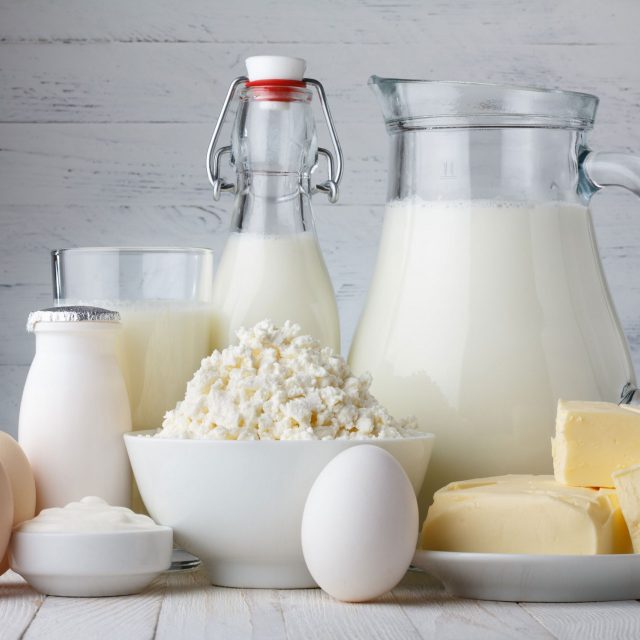How do I maintain a balanced diet?
Milk and other food products are an important source of nutrients in our diet. The most important of these nutrients is calcium, which is essential for bone growth and repair throughout our lives. In particular, during middle and old age, a calcium deficiency can lead to thinning and brittleness of the bones, a condition called osteoporosis. In this sense, it raises the issue of inadequate calcium intake, for children and adults who are lactose intolerant, from a diet containing little or no milk.
In 1997, the Institute of Medicine issued a press release recommending new amounts of daily calcium intake. Ultimately, how much calcium a person needs to maintain good health depends on their age group. The recommendations from the Press Release for recommended amounts of daily calcium intake by age group are as follows (Table 1):
| Age Group | Amount of daily calcium intake in milligrams(mg) |
| 0-6 months old | 210 mg |
| 6-12 months old | 270 mg |
| 1-3 years old | 500 mg |
| 4-8 years old | 800 mg |
| 9-18 years old | 1,300 mg |
| 19-50 years old | 1,000 mg |
| 51-70 years old | 1,200 mg |
For pregnant or breastfeeding women under the age of 19 the recommended amount is 1,300 mg daily, while for those over 19 years of age the recommended dose is 1,000 mg.
In conclusion, be sure to include adequate calcium in your daily diet, even if your diet does not include dairy products. There are many non-dairy products that are rich in calcium. Green vegetables such as broccoli and cabbage and soft-boned fish such as salmon and sardines are excellent sources of calcium. To help plan a calcium-rich, low-lactose diet, refer to Table 2, where you will find common foods that are good sources of dietary calcium and next to them the amount of lactose they contain.
Findings from recent research show that yoghurt containing active culture can be a good source of calcium for many people who are lactose intolerant, although it does contain a lot of lactose. Evidence suggests that the bacterial cultures used to make yoghurt produce a lactase enzyme that is needed for proper digestion.
Calcium and Lactose in common foods
| Per capita calcium * | Per capita lactose | |
| Cooked broccoli – 1 cup | 94-177 mg | 0 |
| Cooked Chinese cabbage – 1 cup | 158 mg | 0 |
| Cooked kale – 1 cup | 148-357 mg | 0 |
| Cooked turnips | 94-179 mg | 0 |
Dairy products
| Per capita calcium * | Per capita lactose | |
| Ice cream / frozen milk (224gr) | 176 mg | 6-7 g |
| Milk (full fat – low fat – buttermilk, 224gr.) | 291-316 mg | 12-13 g |
| Processed cheese (28gr) | 159-219 mg | 2-3 g |
| Whipping cream (112gr) | 134 mg | 4-5 g |
| Plain yoghurt (224gr) | 274-415 mg | 12-13 g |
Fish/Seafood
| Per capita calcium * | Per capita lactose | |
| Oysters (raw) 1 cup | 226 mg | 0 |
| Salmon with bones (canned) 84gr | 167 mg | 0 |
| Sardines (84 gr) | 371 mg | 0 |
| Shrimps (canned) 84 gr | 98 mg | 0 |
Other
| Per capita calcium * | Per capita lactose | |
| Sugar syrup (2cc) | 274 mg | 0 |
| Tofu (treated with calcium salts) 84 gr | 225 mg | 0 |
*Nutritional value of food. Value varies, depending on processing and preparation methods.
** Derived from the American Dietetic Association’s Lactose Intolerance, 1991.
Obviously, many foods can provide us with the calcium and other nutrients our bodies need, even when our intake of milk and dairy products is limited. But there are other factors, besides calcium and lactose content, that need to be taken into account when planning a diet. Some vegetables that are rich in calcium (e.g. Swiss cabbage, spinach and rhubarb) are not included in Table 2 because our bodies cannot use the calcium they contain. They contain substances called oxalates, which stop the absorption of calcium. Calcium is only absorbed and used when there is enough vitamin D in our bodies. Therefore, a balanced diet must provide a sufficient amount of vitamin D. Sources of vitamin D include eggs and liver. And the sun, however, helps the body naturally absorb or synthesize vitamin D, and with adequate sun exposure, food sources may not be necessary.
Some people who are lactose intolerant may think they are not getting enough calcium and vitamin D from their diet. In this case, they need only consult a medical specialist or nutritionist to see if they need to take a nutritional supplement. Taking the wrong vitamins or minerals or the wrong amounts can be detrimental to health. A Nutritionist can educate you on this issue.
What is Hidden Lactose?
Although milk and foods made from milk are the only natural sources, lactose is often added to prepared foods. These foods that contain additional lactose, and which those who are glucose intolerant should be aware of, are:
- Bread and other baked goods
- Refined grains
- Cooked potatoes, soups and breakfast drinks
- Margarine
- Meat used for meals (other than kosher)
- Sauces for salads
- Sweets and other snacks
- The mix for pancakes, biscuits and cookies.
Some products that say on their labels that they are non-dairy, such as coffee cream powder and whipped cream, may also contain milk-derived ingredients and therefore contain lactose.
Smart consumers are learning to read food labels carefully, looking not only for milk and lactose among the ingredients, but also for words such as, whey, curd for cheese, milk by-products, milk solids, dry milk solids and non-fat dry milk powder. If any of these are listed on the label, then the product contains lactose.
In addition, lactose is used as the base for more than 20% of prescription drugs and more than 6% of over-the-counter drugs. For example, many types of birth control pills contain lactose, as do some tablets for stomach acid and stomach gas. These products, however, typically only affect people with a severe form of lactose intolerance.


